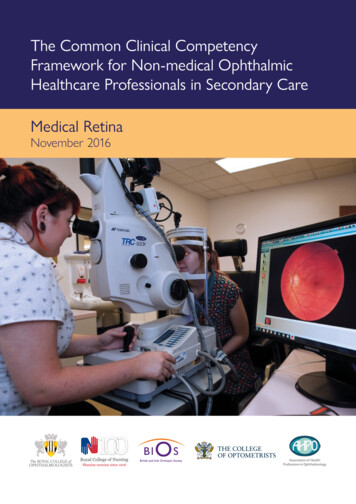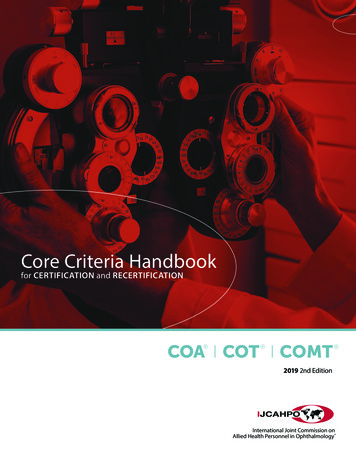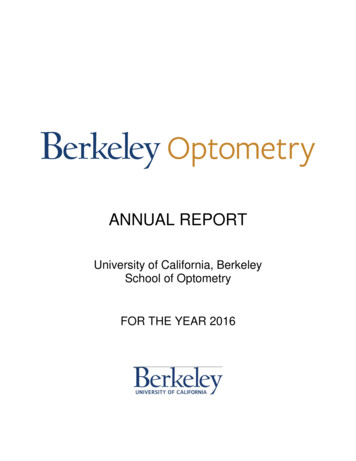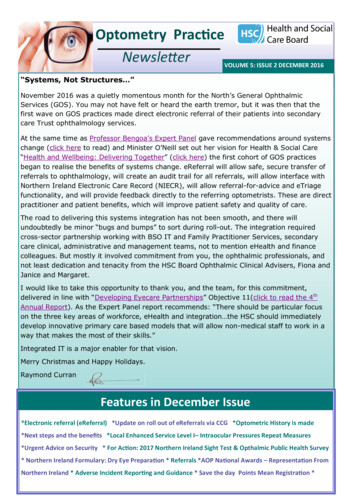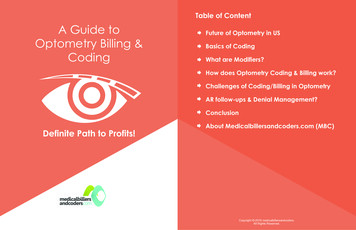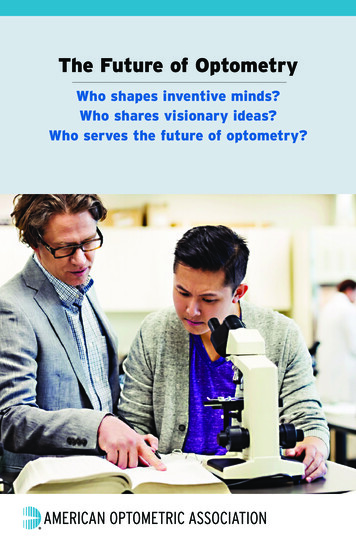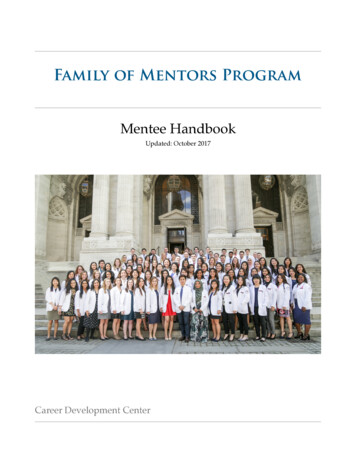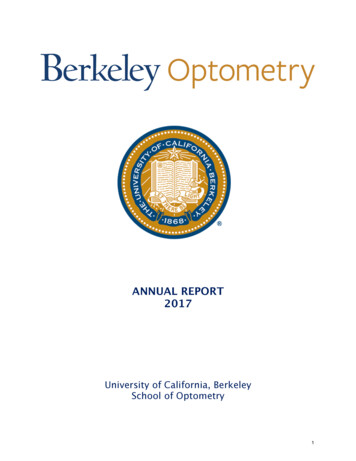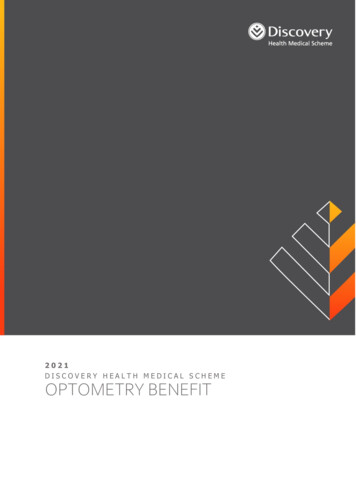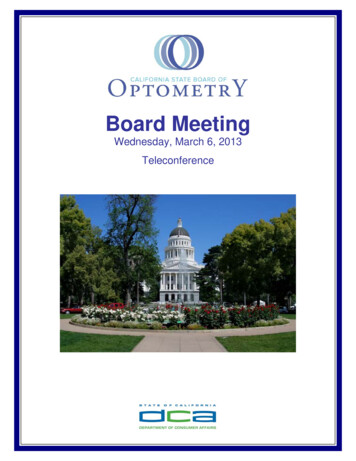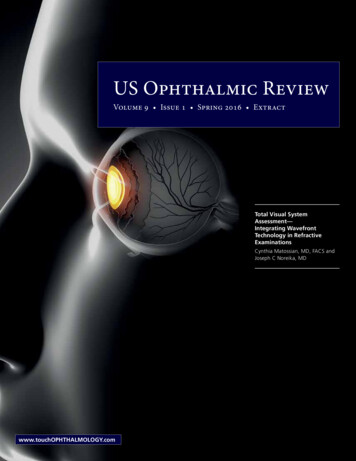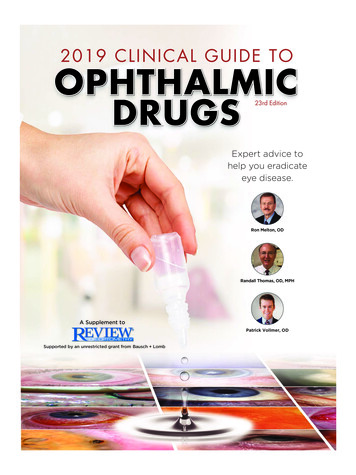
Transcription
2019 CLINICAL GUIDE TOOPHTHALMICDRUGS23rd EditionExpert advice tohelp you eradicateeye disease.Ron Melton, ODRandall Thomas, OD, MPHA Supplement toPatrick Vollmer, ODSupported by an unrestricted grant from Bausch Lomb001 dg0519 Cover.indd 35/14/19 3:39 PM
FROM THE AUTHORSDEAR OPTOMETRIC COLLEAGUES:Welcome to the 2019 edition of our annual Clinical Guide to OphthalmicDrugs. In these pages, we offer you our collective clinical wisdom, gleanedfrom over 75 years of combined experience, and the latest information ondevelopments in ocular therapies and care to help you in your daily practice.Though advancements are always welcome, technology is a two-edgedsword that can truly cut both ways. For example, refraction can nowbe performed by any number of scanning devices. And in many parts ofthe world, automated refraction is the only way to provide people withcorrective lenses. 3D printers can now produce eyeglasses. Even morestrikingly, eye drop technology will soon be available to dampen the onsetand degree of presbyopia. We all know such advances will only continue.What we are getting at here is our strong admonition to begin diversifyingyour practice to embrace more medical eye care services. This is especiallyimportant for younger clinicians, since refractive-centric practices are alreadyat risk of being replaced by technology. The time to plan ahead is now.Turning to the state of advancing therapies, the drug pipeline has beeninfluenced by the patent expiration of Restasis and the advent of numerousgenerics. Yet another new glaucoma drug was approved, as well as anon-BAK-preserved formulation of latanoprost. We now have a medicinespecifically indicated to help patients with neurotrophic keratitis. Anda micro-particle delivery system for loteprednol was approved for BIDadministration, in addition to a newer 0.38% Lotemax SM available forTID, both of which are indicated for postoperative care. Soothe XP isnow offered in preservative-free unit-dose packages, AREDS2 vitaminsupplements now come in chewable tablets, and a new supplementcontaining lutein and zeaxanthin is formulated to help guard against bluelight macular phototrauma.This year, as in past years, we will help you to better understand howto use available ophthalmic medicines as well as discuss these newermedications. And we will continue to emphasize the increasingly importantrole of systemic medications in the care of patients who present tooptometrists.Medical care may be a science, but it’s also an art. No treatment isfoolproof and methods vary among practitioners. We are pleased to shareour approaches and their rationales with you each year. As always, our goalis to help you better serve and care for patients. Remember to care for themas you would like to be cared for yourself.CONTENTSThoughts from the Chair .3Glaucoma Care .5Corticosteroids .14Antibiotics.23Combination Drugs .28Ocular Surface Care.32Allergy Drugs.38Shingles Therapy . 42Vision Insights . 45Practice Management. 48With our best wishes,Randall K. Thomas,OD, MPH, FAAOSupported by anunrestricted grant fromBausch LombRon Melton,OD, FAAOPatrick M. Vollmer,OD, FAAODisclosure: Drs. Melton and Thomas are consultants to, but have no financialinterests in, the following companies: Bausch Lomb/Valeant and Icare.Dr. Vollmer has no financial interests in any company.A PEER-REVIEWEDSUPPLEMENTNote: The authors present unapproved and “off-label” uses of specific drugs in this guide.002 dg0519 Intro.indd 25/14/19 3:49 PM
THOUGHTS FROM THE CHAIRPersistence Pays OffThe need todiversify yourpractice toinclude medicaleye care isbecomingapparent. Here’show I broke intothe local referralnetwork.By Patrick Vollmer, OD, FAAOIpurchased my practice in October 2016,shortly after completing my residency.Like most new grads, I was eager tomake an immediate impact in my newlydiscovered community. Patients weregoing to line up at my door, recommendmy services to their family and friends and,perhaps most importantly, surroundinghealthcare professionals would refer me alltheir complex eye cases. I was going to beswamped in no time.But that didn’t happen at least notright away. One month into practice, I realized patients were not just going to spontaneously show up at my door and I wasn’tgoing to be seeing emergency cases frantically sent over by other providers. I wasnew to my community—an outsider—andno one knew me. This was a discovery Imet with early frustration.Just as a financial advisor will encourageyou to diversify your investment portfolio,I knew at the outset I had to diversify myservices. Funding a practice strictly throughretail alone is not infallible, and I had toomuch at stake. Additionally, I had studiedextensively under my coauthors, who manage high-level acute and chronic ocular disease every day, and I understood the impor-Dr. Vollmer’s emphasis on emergency carehelped his practice establish an identity as avital local resource.tance of offering these kinds of importantmedical services. But I can assure you thatsucceeding in medical eye care did not happen overnight, even to a recent grad whowas both well-trained for and enthusiasticabout that role.The first time I met with the medicalcommunity was at a local Urgent Care. Iwaited patiently for the attending physicianto finish examining his patient so I couldTHE VIRTUES OF 24/7 EMERGENCY CAREI don’t personally subscribe to the idea that optimum patient care is a 9-to-5 endeavor. My clinic offers around-the-clock emergency services on nights and weekends.Ironically, about 80% of all these emergency cases are not my existing patients, butrather patients who weren’t able to locate other optometrists during their distress.I’ve found this to be a tremendous practice builder. Patients really appreciate yourwillingness to extend your hours outside of normative realms. The number of true eye“specialists” is severely diminished outside of regular business hours. By making yourselfavailable, you will be tapping into a market that demands your attentive expertise.At the conclusion of every exam, I say, “If you ever have an eye emergency, let meknow first.” This quick comment takes three seconds. Its impact is immeasurable.REVIEW OF OPTOMETRY MAY 15, 2019003 dg0519 Vollmer.indd 335/14/19 3:50 PM
THOUGHTS FROM THE CHAIRtalk with him about the services I couldoffer. When I met him, my attemptsto convey my skills and abilities weredampened by his condescending remarks, including: “Are you old enoughto be a doctor?” “I thought you guysjust prescribe glasses.” “Optometristscan treat pink eye?” (Ha.) The meetingfinished in my humiliation.But I came back to him next week.And the next week. And the weekafter that. I did this at all of the local Urgent Care clinics and medicalpractices, where I continued to be metwith the same initial responses. Despitemy most sincere efforts to explain mypotential role within their clinics, Itypically would leave each one feelingslightly more admonished than the last.Then one day, I was finishing upwork at my desk, and I got a call. Itwas the doctor I met with the first day.“Yes, I have a patient here who is notgetting better on the drops I prescribed.Can you see her?” This initial call wasfollowed by others later that week.The frequency and complexity of thereferred cases began to accelerate witheach successful outcome.I was beginning to establish myselfin the community as a doctor whowould treat ocular emergencies. Witheach case, I would examine the patientand send a one-page report back to thereferring provider detailing my findings with a recommended course ofaction. This brief summary showcasedthe wide array of treatments I couldprovide and brought the referring practitioner closure that their patient was ingood hands.Now, just over two years later, it’sno longer novel to be providing carenot only to the patients of these physicians, but also to the physicians’ families and to the physicians themselves. Iam amicably greeted when I go to visitthem now, and they know they cancount on me to take care of their needs.I’m grateful that I wasn’t just handedthis privilege when I first started out.Professional development, networking and reputation-building take time.This is how it’s supposed to be. 4HOW I BECAME A RELUCTANT INTERNET STARTo give you an idea of the inroads one new optometrist can have in a community, my recent case—referred to me from a local Urgent Care—wentviral on social media and wascovered on news outlets fromNewsweek to the Daily Mail.When I first posted picturesApril 28 of a Pseudomonasulcer, directly caused by apatient sleeping in contactlenses, I had no idea that morethan 30 million people wouldsee it in the first three days. ButI’m thrilled the case is raisingThe patient’s ulcer grew from a “small ucler”awareness on this importantnoted at Urgent Care to this—in just 36 hours.issue and, hopefully, helpingto correct unhealthy patientbehaviors when it comes tocontact lens wear.I started the patient on fortified antibiotic drops aroundthe clock and recently addedsteroids to reduce permanentscarring. While this patient’s eyecontinues to drastically improvefrom baseline, she will likelyAround-the-clock fortified antibiotic dropsexhibit some form of residualvision loss even after treatment. and steriods have helped the patientThis problem is not new. This considerably. But she will likely haveis the fourth case of culturedpermanent vision loss of some kind.Pseudomonas I’ve treated inmy clinic—remember, I’ve been practicingfor less than three years—and I constantlyhear from patients, “I sleep in my contactsall the time and I’ve never had a problem.”Disturbingly, the adoption—and increasingly popular overnight use (or misuse)—of soft extended-wear contact lenses asa convenient method for correction ofroutine refractive errors has been associated with a dramatic increase in cases ofmicrobial keratitis in eyes not otherwisepredisposed to this condition.I never recommend sleeping in softcontact lenses. The risks outweigh thebenefits every time. It takes seconds toremove your contacts but risks a potential lifetime of irreversible damage if youdon’t.A MESSAGE FROM DRS. MELTON AND THOMASWe are most happy to recommend Dr. Vollmer as a lecturer for optometriccontinuing medical education programs. He has developed a series of clinicalcase presentations that perfectly represents the pinnacle of optometric patientcare. He can be contacted at: patrickvollmer23@gmail.com.REVIEW OF OPTOMETRY MAY 15, 2019003 dg0519 Vollmer.indd 45/14/19 3:50 PM
GLAUCOMACAREDETECT AND PROTECT THEOPTIC NERVEWithglaucoma,properdiagnosis andcareful followup are crucialto protectingagainst opticneuropathy.Be sure to“look beforeyou leap”into medicaltherapy.Glaucoma management hasbecome a hot topic in optometry these days with therecent approval of severalnew drugs to reduce IOP.Yet, we shouldn’t lose sight of the ultimategoal when managing glaucoma patients:protecting the optic nerve.In fact, critical observation of the opticnerve is far more important than measuringIOP. Many patients who have statisticallynormal IOPs experience glaucomatous optic neuropathy—or perhaps they do haveelevated pressures but these episodes occuroutside of normal office hours. We wouldmiss diagnosing these patients if IOP wasour only driving force to pursue a moredetailed glaucoma workup.The final common pathway of all formsof glaucoma is optic nerve head atrophyas evidenced by progressive cupping withconcurrent thinning of the neuroretinalrim tissue. Especially in older patientswith normal-tension glaucoma, such cupping can be quite elusive, as in the case ofa shallow cup with very thin rim tissue. Ittakes attentive study of these types of optic nerve heads to detect subtle advancedcupping.So, how can eye doctors make sure theydon’t miss glaucoma? The key is a comprehensive patient evaluation. Here is ourusual workup:We begin with a detailed familyhistory, especially if there are siblings with glaucoma. While glaucoma isnot inherited per se, it does tend to run in1.This optic nerve sustained severe loss ofneural tissue, thus showing a C/D ratio of 0.8.families. We look at the patient’s overallhealth status and medications they are taking. It is important to know that oral betablockers have a slightly protective effect,whereas calcium channel blockers such asNorvasc (amlodipine besylate, Pfizer) canbe significantly detrimental.We then measure IOP, corneal thickness and the retinal nerve fiber layer,followed by a 24-2 SITA fast visual fieldand a four-mirror gonioscopic evaluation.Most importantly, we attentivelystudy the optic nerve head. This laststep isn’t as easy as it sounds. A recent report found “there is little consistency in theway clinicians are taught how to identifythe disc and rim margins,” and disc examination is variable between clinicians.1 Thestudy found fellowship-trained glaucomaspecialists show substantial differences in2.3.REVIEW OF OPTOMETRY MAY 15, 2019005 dg0519 Glaucoma.indd 555/14/19 3:52 PM
GLAUCOMA CARETOPICAL GLAUCOMA DRUGSBRAND NAMEGENERIC NAMEBeta BlockersBetaganlevobunolol hydrochlorideCONCENTRATION BOTTLE SIZEAllergan and generic5ml, 10ml5ml, 10ml, 15ml5ml5ml, 10ml, 15ml5ml, 10ml, 15ml2.5ml, 5ml5ml, 10ml, 15ml5ml, 10ml, 15mlunit-doseunit-dose2.5ml, 5mlBetimoltimolol hemihydrateAkornBetoptic-SIstalolTimopticbetaxolol hydrochloridetimolol maleatetimolol maleateTimoptic (preservative-free) timolol maleateNovartisBausch LombBausch Healthand genericBausch HealthTimoptic-XEtimolol maleateBausch %0.25%Prostaglandin AnalogsBimatoprostLumiganTravatan bimatoprosttravoprosttravoprostlatanoprostene bunodlatanoprostlatanoprost ophthalmic usch LombPfizer, genericSun 0.005%0.0015%2.5ml, 5ml, 7.5ml2.5ml, 5ml, 7.5ml2.5ml, 5ml2.5ml, 5ml2.5ml, 5ml2.5ml5mlunit-doseAlpha AgonistsAlphagan .1%, 0.15%0.15%, 0.2%5ml, 10ml, 15ml5ml, 10ml, 15mlCarbonic Anhydrase InhibitorsAzoptbrinzolamide suspensionTrusoptdorzolamideNovartisMerck and generic1%2%5ml, 10ml, 15ml5ml, 10mlRho Kinase InhibitorsRhopressaAerie Pharmaceuticals0.02%2.5mlAllerganAkorn and genericAkornAerie %, 0.005%1%/0.2%5ml, 10ml5ml, 10mlunit-dose2.5ml8mlnetarsudilCombination Glaucoma amide/timololCosopt PFdorzolamide/timololRocklatannetarsudil and siontheir optic nerve head tissue estimatesin glaucomatous or at-risk eyes.The takeaway here is that criticalassessment of the micro-neuroanatomy of the optic nerve head is trulysubjective, and all eye doctors struggle with detailed assessment. We lookback through our own records andare dismayed at the inconsistency ofour quantitative grading and tissuecharacterization. It’s oddly reassuringthat such inconsistency occurs at alllevels of clinical expertise.6MANUFACTURERLuckily, numerous tests and clinical parameters exist to help us followglaucoma patients, so being a little irregular with a single observation carries no meaningful impact to qualityof life concerns.Once these steps are complete, wecan assess risk and decide whetherto follow the patient, the frequencyof follow-up and whether to initiatetherapy. If therapy is initiated, we always do a monocular therapeutic trial. Most importantly, we spend timeexplaining the situation to the patientand thoroughly answer all of theirquestions. If we read skepticism onthe patient’s face (which is very rare),we suggest getting a second opinion,and we recommend several glaucomasubspecialists in the area. This furtherassures the patient that we do, indeed,know what we’re talking about.Whether the patient’s IOP is highor normal, the ultimate goal is to reduce it to a target range you feel issafe for that individual.REVIEW OF OPTOMETRY MAY 15, 2019005 dg0519 Glaucoma.indd 66/4/19 3:27 PM
FROM THELITERATURETODAY’S PERSPECTIVE ON RHO-KINASE INHIBITORSAn exhaustive “translational science review” on this topic was published inthe November 2018 issue of Ophthalmology, with several observations worthy of sharing: Under normal physiological conditions, about 15% of aqueous humorexits via the uveoscleral pathway. Prostaglandins greatly shift aqueousoutflow through the uveoscleral tissues. “Brimonidine may lower IOP, in part, by stimulating prostaglandinrelease.” “Approximately 40% to 50% of patients require two or more medications to adequately lower intraocular pressure.” Current commonly used glaucoma medications adjunctive to prostaglandins reduce IOP by 1.5mm Hg to 3mm Hg. In keeping with thistrend, “Netarsudil lowers IOP approximately an additional 2mm Hg whenadded to a prostaglandin [ ] however, the incidence of adverse eventsis higher.” “Rho-kinase inhibitors have a variety of effects. They can increase bloodflow by causing vascular smooth muscle relaxation leading to vasodilation. On the ocular surface, this can lead to conjunctival hyperemia.”Such action also causes smooth muscle cell relaxation in the trabecularmeshwork. Conjunctival hyperemia was observed in about 50% of patients and the“incidence and severity remained stable through the three-month studyperiod.” Paralimbal subconjunctival hemorrhages were seen in about 14% ofpatients, and about 10% developed corneal verticillata—neither of whichhave any clinically significant bearing. These conditions resolved afterdrug discontinuation. “It is notable that a large proportion of patients withdrew from clinicaltrials because of adverse events, raising some questions about the easewith which these agents can be used in clinical practice.” “Although these agents have been shown to be effective in loweringintraocular pressure, both as monotherapy and adjunctively with betablockers and prostaglandin analogues, their side effect profile raises serious concerns about the likelihood of their acceptance by patients.”As we earnestly strive to share clinical knowledge with our colleaguesto enhance patient care, we also want to share our perspectives. First, if anadjunctive medicine to a prostaglandin is needed, it is abundantly evidentthat timolol is the drug of choice because of its dosing regimen, cost andefficacy.Perhaps even more importantly, and in acknowledgement of the realitythat adding any adjunctive medicine adds further expense and complexity tothe regimen, target-range IOP might be achieved by simply switching from astandard prostaglandin to Vyzulta, which has been shown to further reduceIOP.Do not let us persuade you here; instead, we invite you to think along withus as we ponder how to best serve our patients based on medical literatureand our many combined decades of caring for patients with glaucoma.Tanna AP, Johnson M. Rho kinase inhibitors as a novel treatment for glaucoma and ocularhypertension. Ophthalmology. 2018;125(11):1741-56.THERAPEUTIC TOOLBOXNow, let’s turn our attention to thetherapeutic armamentarium availableto us to reduce IOP.If the patient has established glaucoma as evidenced by visual field defects that correspond to your observation of the optic nerve head, the IOPneeds to be reduced generally intothe low- to mid-teens. Here we usually initiate prostaglandin therapy;our newest option in this categoryis Vyzulta (latanoprostene bunod0.024% ophthalmic solution, Bausch Lomb), which we have found to bemost effective at reducing IOP.If, on the other hand, the opticnerve is healthy but the IOP is perhaps28mm Hg, and we want to decreasethe IOP into the low 20s, we mightselect a beta-blocker for both efficacyand cost; however, in most instances,we simply follow the patient withouttherapy every six months and repeattesting annually. Don’t be in a hurryto treat. Glaucoma, on average, progresses at about 3% per year, so norush—rather, timely attentivenessand follow-up are the keys.Daily dosing options. The prostaglandins have been the drugof choice for initial therapysince 1996, when latanoprost first came to marketunder the brand name Xalatan (Pfizer). While thereare now several prostaglandins to choose from,they all work about thesame, with the exceptionof Vyzulta (see, “Vyzulta: A One-Two Punch toIOP”).REVIEW OF OPTOMETRY MAY 15, 2019005 dg0519 Glaucoma.indd 775/14/19 3:53 PM
GLAUCOMA CAREVYZULTA: A ONE-TWO PUNCH TO IOPWhile Vyzulta is primarily a prostaglandin, it has a secondary effect on trabecular outflow beyond its enhancement of uveoscleral outflow. This is a single molecule that is cleaved by intrinsic esterases to also release nitric oxide, which isthe biochemical stimulant of trabecular meshwork outflow.This secondary effect is what separates this medicine from the other prostaglandins. Vyzulta reduced IOP anywhere between 7.5mm Hg and 9.1mm Hg inPhase III studies.1-3 In preapproval studies, Vyzulta decreased IOP an average of1.23mm Hg beyond that of latanoprost.1-3 The significance here is that severalindependent studies have established that every millimeter reduction in IOPresults in a 10% decrease in the risk of glaucoma progression.4-6As a prostaglandin, Vyzulta performs maximally when instilled in the eveningand, as with latanoprost, is stored under refrigeration at pharmacies. However,Vyzulta can be kept at room temperature for up to two months once it hasbeen dispensed to the patient. It shares a high tolerability profile with latanoprost and its 0.2% benzalkonium chloride preservative. Further distinguishingVyzulta, it comes in both a 2.5mL and a 5mL bottle.We know that about half of all glaucoma patients end up requiring a secondeye drop as they age to further decrease IOP. By using Vyzulta with its dualeffect, our hope is that we can push the need to add a second drop furtherdown the road. Any time we can decrease therapeutic complexity, it enhancesadherence and intraocular pressure control.As with all branded products, coupons greatly reduce the cost to the patient.Also, many new drugs require prior authorization, so Bausch Lomb has contracted with a company (parxsolutions.com) to help streamline this encumbrance.1. Weinreb RN, Sforzolini S, Vittitow J, Liebmann J. Latanoprostene bunod 0.024% versus timololmaleate 0.5% in subjects with open-angle glaucoma or ocular hypertension: The APOLLO study. Ophthalmology. 2016;123(5):965-73.2. Medeiros FA, Martin KR, Peace J, et al. Comparison of latanoprostene bunod 0.024% and timololmaleate 0.5% in open-angle glaucoma or ocular hypertension: the LUNAR study. Am J Ophthalmol.2016;168:250-59.3. Kawase K, Vittitow JL, Weinreb RN, et al. Long-term safety and efficacy of latanoprostene bunod0.024% in Japanese subjects with open-angle glaucoma or ocular hypertension: the JUPITER study.Adv Ther. 2016;33(9):1612-27.4.Heijl A. Glaucoma Treatment: by the highest level of evidence. Lancet. 2015;385(9975):1264-6.5. Leske MC, Heijl A, Hussein M, et al. Factors for glaucoma progression and the effect of the treatment.Arch Ophthalmol. 2003;121(1):48-56.6. Bengtsson B, Leske MC, Hyman L, et al. Fluctuation of intraocular pressure and glaucoma progression in the early manifest glaucoma trial. Ophthalmology. 2007;114(2):205-9.Recently, Xelpros (latanoprost0.005% ophthalmic emulsion, SunPharmaceuticals) became our onlyversion of latanoprost not preservedwith benzalkonium chloride—it uses0.47% potassium sorbate instead.No refrigeration is required for longterm storage, and, as with the originallatanoprost, it is dosed once daily inthe evening. However, be aware thatyou can’t just “prescribe” Xelpros, asit’s not available in retail pharmacies.This medication can only be orderedthrough the manufacturer’s two contracted pharmacies via XelprosXpress.If we are unable to achieve the target range IOP with a prostaglandin,8we almost always add a beta-blocker,usually timolol, for three reasons: (1)it is inexpensive, (2) it is administeredonce daily and (3) it has good efficacy.Nonselective beta-blockers such astimolol reduce IOP about 25%,which is not that much less thanthe 30% to 35% reduction seenwith the prostaglandin class.Systemic beta-blockers arealways among the top 10 mostprescribed medicines in theUnited States because they areprescribed for a wide variety ofheart conditions. Beta-blockersare quite safe, with the significant exception of their use inthe setting of clinically expressed asthma. Always inquire about a history ofasthma prior to prescribing any topicalbeta-blocker.Timolol has a long half-life, which iswhy it can be used once daily. Timololis ineffective during the nocturnal sleepcycle, so it requires morning administration. We use the 0.25% formulationfor patients with lightly pigmented irides (usually Caucasians) and the 0.5%for patients with darkly pigmentedirides since melanin pigments tend toabsorb some of this medicine.Of our numerous glaucoma patients, 80% to 85% use a prostaglandin drop alone, timolol alone or a combination of the two.Another relatively new once-dailyglaucoma medication is Rhopressa(netarsudil 0.02%, Aerie Pharmaceuticals), which works exclusively at thetrabecular meshwork to enhance aqueous outflow. Pilocarpine, a parasympathomimetic, also potentiates aqueous outflow, but through a differentmechanism; it causes contraction ofthe longitudinal muscles of the ciliarybody, mechanically opening the porous trabecular tissues. Because of itsQID frequency of administration, accommodative spasm, brow ache andmiosis, pilocarpine quickly fell out offavor once beta-blockers came to market in 1978.Rhopressa works through a rho-kinase (ROCK)–mediated chemical system that reduces IOP on average about4mm Hg to 5mm Hg and is used oncedaily, usually in the evening, as withthe prostaglandins. The Achilles heelof Rhopressa is its proclivity to causesignificant conjunctival hyperemia, which is likely to limit itsacceptability for many patients.Rhopressa can cause an amiodarone-like verticillata depositionin the cornea, although this hasno clinical significance. Further, some patients may experience some subtle paralimbal,splotchy and transient subconjunctival hemorrhages, also withno known clinical significant.REVIEW OF OPTOMETRY MAY 15, 2019005 dg0519 Glaucoma.indd 85/14/19 3:53 PM
THE CASE FOR PILOCARPINEA 49-year-old female has long been treated for open-angle ocular hypertension (baseline IOPs in the high 30s) with a prostaglandin and Combigan. She had 0.5 cups and healthy optic nerves when she became our patient. Her IOPs have been maintained in the low 20s during these past years. All testing is normal. Now she and her husband are trying in vitro fertilizationto have a child. We wanted to see if her glaucoma medicines could be stopped during her anticipated pregnancy, so we performed a standard discontinuation trial. The patient returned in about two weeks complaining that her eyes were uncomfortable, and we found that her non-treated IOPs were in the low 60s.While we needed to avoid a prostaglandin during pregnancy because of the rare possibility of uterine contractions, she desperately needed something. We consulted three different glaucoma subspecialists, all of whom had nothing to offer and sentthe patient back to us. We then telephone consulted with a university medical center glaucoma specialist who had an idea:he recommended we restart the patient on Combigan and try 1% pilocarpine QID, since these three drugs are relatively safe.We also inserted punctal plugs in her lower eyelids to further minimize any systemic absorption. This approach brought ourpatient’s IOPs into the mid to upper 20s during the course of her successful pregnancy, and she tolerated the pilocarpine well.Now at age 51, the patient has a healthy two-year-old and is back on a prostaglandin along with Combigan. Although thepilocarpine was a successful treatment avenue, it required QID dosing, and it is much simpler for her to use the once-dailyprostaglandin.Clinicians should also consider pilocarpine for the patient with advanced glaucoma who is on maximum medical therapy (aprostaglandin with one of the four combination drugs). Of the typical glaucoma medication classes, only prostaglandins provide a clinically significant nocturnal effect on IOP reduction. Adding 1% or 2% pilocarpine at bedtime may further reduce IOPduring the night, when IOP has been documented to be highest.Although Rhopressa could be used asinitial monotherapy, its role as adjunctive therapy to a prostaglandin remainsill-defined.Rocklatan (Aerie)—a combinationof netarsudil 0.02% and latanoprost0.005%—gained approval in March2019 and is the newest once-dailymedication that capitalizes on both thetrabecular meshwork and uveoscleraloutflow pathways to lower IOP. Weare strongly philosophically opposedto all combination glaucoma medicines as first-line therapy because IOPmay well be achieved with one-agentdrugs. However, to give Rocklatanits due, clinical trials found that morethan 60% of patients taking the drugachieved an IOP reduction of 30%or more, a frequency that was nearlytwice that achieved by participantstaking latanoprost alone.2But remember that cost is a majordeterrent to patient adherence withtheir glaucoma medications. We askall of our colleagues to not immediately jump at the possibility of a newcombination medicine; rather, be patient-centric in your decision-makingand prescribing. In most cases, wewould first try generic latanoprost tosee if it achieves a target IOP range. Ifthe latanoprost comes close to targetbut does not quite reach it, then weKEEPIN MINDGLAUCOMA PEARLSAND PONDERINGS Most patients can tolerate an IOP of 30mm Hg for many years and maynever require treatment—although they merit close follow-up.
Welcome to the 2019 edition of our annual Clinical Guide to Ophthalmic Drugs. In these pages, we offer you our collective clinical wisdom, gleaned from over 75 years of combined experience, and the latest information on developments in ocular therapies and care to help you in your daily practice.
